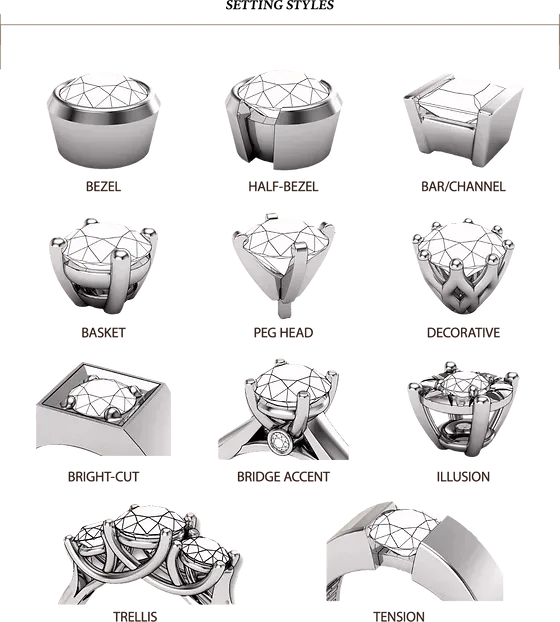
Setting Styles
The first row shows examples of Bezel and Bar settings. A bezel setting wraps metal completely around the stone, making it the most secure option. A variation of this is the half bezel, where metal is removed from opposite sides to reveal more of the stone and allow more light to enter, enhancing its brilliance. The bar setting uses vertical metal bars on either side of the stone to hold it in place. When multiple bar settings are used in a row, the style is known as a channel setting.
In the second row, we see more traditional prong-based settings. The basket setting is a classic design, typically using four, six, or even eight prongs supported by one or two rings of metal for added stability. Next is the peg head setting, which sits higher on the ring and is mounted directly onto the shank. This creates what's known as a cathedral setting, named for its elegant, arch-like rise. The final example in this row is a decorative mounting, which features prongs but with more ornate or unique design elements rather than a standard basket or peg head.
The third row explores some alternative setting styles that still use prongs or prong-like elements. A bright cut setting features polished metal edges around the stone, making the stone appear larger and adding extra shine. The stone is set lower for better protection. In the center is a diamond-accented setting, similar to a basket setting but with an added bezel-set accent diamond to enhance both structure and sparkle. The last setting in this row is an illusion setting, which also aims to make smaller stones appear larger through the use of reflective or contoured metalwork around the stone.
In the final row, we see another version of the channel setting, which in this case can also be referred to as a tension setting.
Tension settings often have no metal beneath the center stone and rely on the pressure of the ring’s sides to hold the stone in place, giving it a "floating" appearance. Also featured is the
trellis setting, known for its sweeping, overlapping metal arms that form a graceful structure beneath the stones. This style is most commonly used in three-stone ring designs.
